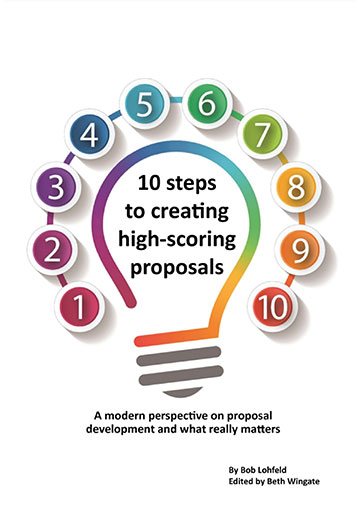Breakthrough Strategies to Win AETC’s $4B BOS MAC

The Air Education Training Command’s (AETC) Base Operations Support (BOS) Multiple Award Contract (MAC) released a new draft request for proposal (DRFP) on April 1, 2025, and other pre-RFP documents, including the long-awaited instructions and evaluation criteria, on March 31, 2025. Table 1 presents basic identification information about the bid.
Table 1: AETC BOS MAC At-a-Glance
| Identifier | Bid Identification Information |
| Value | $4B |
| Type | Multiple Award Contract (MAC) Indefinite Delivery/Indefinite Quantity (IDIQ) |
| Competition Type | Pool 1 – Small Business Set-aside and Pool 2 – 8(a) Set-aside Note: Only one AETC BOS MAC IDIQ program contract will be awarded per offeror. However, the government intends to award multiple BOS MAC IDIQ awards to qualifying offerors in the two pools. |
| NAICS Code | 561210 (Facilities Support) |
| Place of Performance | Altus, Columbus, Goodfellow, Holloman, Keesler, Laughlin, Luke, Maxwell, Sheppard, and Vance Air Force Bases, as well as other OCONUS locations. |
| Industry Day | April 24, 2025, at 9:00 AM CDT |
| Incumbents | ASRC, Akima, and Chugach |
Industry Day, Bidder’s Library, and Questions and Answers (Q&A)
The government will sponsor an industry day on April 24, 2025, at 9:00 AM CDT. Attendance at the event is limited to no more than three attendees per offeror. All offerors are required to RSVP to the event by April 23 at 4:00 PM CDT.
To receive the bidder’s library documents, offerors must register by emailing Section L, Attachment 8, Registration for AETC BOS MAC to the following: kari.barnett@us.af.mil, ricardo.flores.16@us.af.mil, paul.lewis.16@us.af.mil, kathryn.van_horn@us.af.mil, and donna.sims.1@us.af.mil. The government encourages pre-RFP release Industry Day questions before the final RFP release. The Government will post answers via a consolidated list on SAM.gov.
Analysis of Section L Instructions
Offerors must submit their proposals in three volumes, as shown in Table 2.
Table 2: AETC BOS MAC Volume
| Volume | Volume Title | Page Limit |
| I | Technical includes: Table of Contents (not included in the 50-page limit)List of Tables and Figures (not included in the 50-page limit)Subfactor One (1) – Base OperationsSubfactor Two (2) – Workforce ManagementSubfactor Three (3) – Performance ManagementCross-Reference Table (not included in the 50-page limit)Glossary (not included in the 50-page limit) | 50 |
| II | Past Performance | 30 |
| III | Responsibility/Contracting Documentation | Unlimited |
| Note: The transmittal letter, cover pages, tab-divider pages, title pages, table of contents, cross-reference matrix, tables list, drawings, glossary, and acronyms are excluded from the page count. | ||
Section L – Instructions, Conditions, and Notices to Offerors provides comprehensive proposal preparation guidance. Here are some of the most important points:
- Proposal Requirements: Proposals must be clear, concise, and detailed to support a practical evaluation. Offerors must demonstrate an accurate understanding of requirements and propose viable solutions. The proposal should provide a convincing rationale and specific examples of processes to meet the requirements.
- Evaluation Criteria: Proposals will be evaluated based on their clarity, coherence, and ability to substantiate claims. Unsupported or vague statements are inadequate and will negatively impact evaluation.
- Specific Instructions: Proposals must include all data and information requested for the chosen competition pool. Proposals must adhere to the format specified in the solicitation, including page limitations and volume organization. Proposals must be submitted via the specified electronic platforms (e.g., PIEE Solicitation Module).
- Compliance and Eligibility: Offerors must comply with the Performance Work Statement (PWS) and the entire solicitation. Incomplete proposals are ineligible.
- Communications and Amendments: Any amendments to the solicitation must be acknowledged, and proposals may be modified or withdrawn before an award.
- Additional Requirements: The draft RFP outlines requirements for past performance, organizational changes, and financial responsibilities. Offerors must provide detailed information on teaming arrangements and subcontracting.
Analysis of Section M Evaluation Criteria
Here’s what every proposal professional should know for this bid:
- Earn an Acceptable Rating for the Technical Factors (Volume I), which addresses three subfactors which are rated acceptable or unacceptable:
- Base Operations: Demonstrate capability in delivering Operations and Maintenance servcies, including managing utility systems.
- Workforce Management: Provide a detailed workforce strategy for recruiting, training, and retaining personnel, including innovative solutions for maintaining coverage.
- Performance Management: Present a Quality Management System (QMS) approach that aligns with ISO 9001:2015 standards, showing precise methods to manage quality and performance discrepancies
Anchor every claim with processes, tools, methods, and proof points–not just outcomes. Include org charts, matrices, and quality loops that show mastery of scope and minimization of risk.
An “Unacceptable” in any subfactor renders the proposal ineligible. No bonus points exist for exceeding the requirements; Section M explicitly states that exceeding the evaluation criteria will not result in a higher rating. Avoid overengineering your solution and focus on clearly meeting the standards described for each subfactor and element.
- Earn a Substantial Confidence Rating for the Past Performance (Volume II):
- The offeror’s past performance is rated as substantial, satisfactory, neutral, limited, or no confidence. Only proposals with a substantial confidence rating will be eligible for the award. To get there, your past performance must be recent (at least 12 months within the last 5 years), relevant (similar in scope, magnitude, and complexity), and of high quality (based on CPARS or past performance questionnaires (PPQs) without adverse trends).
- Each pool requires coverage of six specific service areas, and at least three of the six contracts must be from the Prime (or Joint Venture partners, not just subs). So, build your past performance library before the RFP drops. Analyze and map your experience to each service area and verify that you meet dollar value, technical complexity, and quality thresholds
- All the past performances you submit must be strong. The government is scoring your past performance in aggregate. Assemble past performance questionnaires and CPARS records to substantiate past performance.
- There’s No Room for Ambiguity: The government won’t search your proposal for answers or reconcile inconsistencies. If something is missing or unclear, your rating is at risk. Use compliance matrices, proofing checklists, and color team reviews to verify that your proposal is responsive, complete, and aligned with Section L and Section M instructions.
- Prepare for Award Without Discussions: The government intends to award without discussions. You won’t get a second chance to fix mistakes.
- Focus on Low-Risk, High-Confidence Messaging: The evaluation is heavily weighted toward assessing risk and confidence. Examine your technical response to verify that it exudes reliability, provides an organizational structure ready to handle surges and changes, and demonstrates continuity, professionalism, and successful outcomes in your past performance. Write from a position of control and readiness. Provide evidence of your achievements, describe the methods used, and illustrate your current preparedness.
- Responsibility and Documentation Matter: Although Volume III (Contract Documentation) is not rated, it’s still a gate. You’re out if you don’t meet responsibility criteria (e.g., approved accounting system, FAR 9.1 responsibility).
Summary Checklist for Success
- Ensure you have a fully compliant proposal aligned with the right pool
- Follow all RFP sections to the letter
- Earn an acceptable rating on all three technical subfactors
- Tailor each response to elements in M.3.1 (Technical Factor)
- Earn substantial confidence in past performance
- Cover all six focus areas in M.3.2, Tables M.4 or M.5
- Show proof of an approved DFARS accounting system
- Confirm Defense Contract Audit Agency (DCAA), Defense Contract Management Agency (DCMA), or CPA approval
- Be prepared for responsibility determinations, as per FAR Subpart 9.1
- Demonstrate NIST 800-171 & SPRS compliance
- Include documentation and SPRS score
- Include Standard Form 33 (SF 33) and representations and certifications
- Take a clear, specific, and risk-mitigating approach
- No generic fluff—show readiness
Conclusion
This is a gateway contract. If you meet the bar, you get in the pool. From there, the real competition begins at the Task Order level. So, don’t swing for creativity or uniqueness. Aim for clarity, compliance, and confidence—that’s what gets you in the game.
Relevant Information
By Brenda Crist, Vice President at Lohfeld Consulting Group, MPA, CPP APMP Fellow
Lohfeld Consulting Group has proven results specializing in helping companies create winning captures and proposals. As the premier capture and proposal services consulting firm focused exclusively on government markets, we provide expert assistance to government contractors in Capture Planning and Strategy, Proposal Management and Writing, Capture and Proposal Process and Infrastructure, and Training. In the last 3 years, we’ve supported over 550 proposals winning more than $170B for our clients—including the Top 10 government contractors. Lohfeld Consulting Group is your “go-to” capture and proposal source! Start winning by contacting us at www.lohfeldconsulting.com and join us on LinkedIn, Facebook, and YouTube(TM).
Paperback or Kindle
10 steps to creating high-scoring proposals
by Bob Lohfeld
contributors Edited by Beth Wingate
Subscribe to our free ebrief
Teaming friends, frenemies, and enemies—12 tips to mitigate harmful effects
Did you know that contracting officers spend up to 20% of their time mitigating disputes between teaming partners? In an informal poll we conducted on LinkedIn last month, 40% of respondents classified their teaming partners as “frenemies” on their last bid.
Explore Further
- Advice (538)
- AI (26)
- APMP (18)
- Army MAPS Contracts (3)
- Business Development (292)
- Capture Management (265)
- Complex Technology Grants Services (26)
- Favorite Books (5)
- GenAI (4)
- Go-to-Market (27)
- Graphics (5)
- Lohfeld Books (2)
- NASA SEWP VI Contracts (2)
- Navy SeaPort-NxG Contracts (2)
- NIST MSE Grants (1)
- NIST NAPMP Grants (2)
- Past Performance (63)
- Post-submission Phase (14)
- Pre-RFP Preparation (262)
- Proposal Management (336)
- Proposal Production (75)
- Proposal Reviews (38)
- Proposal Writing (104)
- Pursuit Phase (108)
- Research Report (4)
- Resources (63)
- Tools & Tips (418)
- Training (13)
- Uncategorized (223)

Sign Up for INSIGHTS and Download your FREE book
We'd love to help you with your proposals. Enjoy our complimentary Lohfeld Consulting Group Capture & Proposal Insights & Tips book with your FREE subscription to our Insights Newsletter.
GET YOUR FREE BOOK



